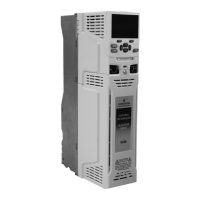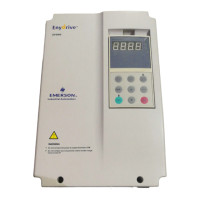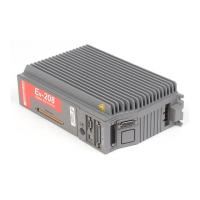Safety
information
Product
information
Mechanical
installation
Electrical
installation
Getting
started
User Menu A Commissioning
Advanced
Parameters
Diagnostics Optimization CT MODBUS RTU Technical Data
E300 Design Guide 453
Issue Number: 1
Vibration during
operation
Speed control loop
If the speed loop I, P gains are set-up incorrectly vibration can occur during any part of
the travel. The speed loop gains are split into 2 sections with the default set-up being
(1) Start speed loop gains and (2) Travel, Stop speed loop gains.
• Refer to Menu I Tuning to adjust the Start, Travel, Stop speed loop gains for both full
load and no load conditions.
• Ensure good EMC practices are followed for the position feedback, induced noise
can limit the level of control loop gain which can be achieved
Position feedback Closed loop
operation)
Check the position feedback in Closed loop operation. Where induced noise is present
on the position feedback cabling this can result in unstable control.
• Ensure good EMC practices are followed with regards to cable routing, screen and
terminations. Refer to Drive Encoder Feedback Filter (C09) which can also be used
to limit induced noise.
Current control loop
The current control loop gains calculated from the autotune may be high for the given
motor and can be manually adjusted or a current control loop filter implemented where
vibration is present. Note there is separate current control adjustment for (1) Start and
(2) Travel-Stop as default.
• Refer to Menu I Tuning to adjust the current control loop under both full load and no
load conditions.
Roll back during start
Speed control loop
During the start on brake release if roll back occurs the start speed loop I gain should be
increased. Excessive values can result in motor acoustic noise and therefore may
require the position lock at start to be enabled. If a low resolution encoder is being used,
or there is induced noise on the position feedback these can limit the maximum speed
loop gain due to acoustic noise and instability.
• Refer to Menu I Tuning to adjust the start speed loop I gain for both full load and no
load conditions.
• Ensure good EMC practices are followed for the position feedback, induced noise
can limit the level of control loop gain which can be achieved
Start position lock
During the start on brake release if the start speed loop I gain is limited due to a low
resolution encoder or there is induced noise on the position feedback the position lock
for start can be enabled.
• Refer to Start Lock P Gain (I20). The start speed loop gains I, P may need to be
reduced to achieve a high P gain setting for the start lock. The start lock should be
set-up for both full load and no load conditions
Load cell compensation
If the Elevator system has a load cell available this can be connected to the drive using
analog input 2 and provide a torque feed forward during the start to overcome roll back.
• Refer to Menu E Mechanical for the Load cell compensation parameters to set-up
compensation. Where the load cell compensation signal is unstable /noisy, a filter
can be implemented with Load Cell Compensation Filter Time Constant (E12)
Reported fault Root cause Recommended actions
Motor goes into current
limit following drive
enable
Motor data, symmetrical
current limit
Ensure the motor data has been set-up correctly in the drive and the symmetrical
current limit has also been set-up for the system.
• Refer to Menu B Motor and Symmetrical Current Limit (B16)
Autotune
For a PM motor and operation in RFC-S if the motor goes into current limit on enable
ensure an autotune has been carried out to derive the correct encoder phase angle, or
this has been entered if known.
• Refer to Motor Autotune (B11)
Position feedback
Check the position feedback if this has failed or connected incorrectly the drive will no
longer operate correctly in either RFC-A or RFC-S.
• Refer to Drive Encoder Position (J53) and check connections to drive encoder port.
• Refer to Drive Encoder Feedback Reverse (C12) to change rotation of encoder
feedback where this is connected incorrectly.
Motor rated speed “slip”
incorrect (Open loop vector,
RFC-A)
The motor is unable to reach the demanded speed due to a limitation in output torque,
current limit operation as a result of the incorrect rated speed “slip”
• Manually adjust the rated speed to achieve the maximum torque in Torque
Producing Current (J24) (Open loop)
• Tune the rated speed to achieve the maximum torque using Motor Parameter
Adaptive Control (B25) (RFC-A)
Motor, motor connection fault
Check the connections from the drive output to the motor including the output motor
contactors and any shorting contactor which may be used.
Reported fault Root cause Recommended actions

